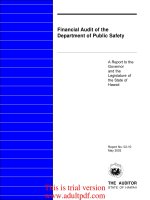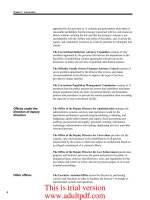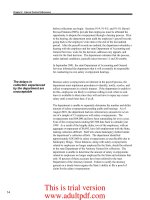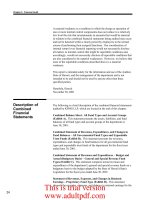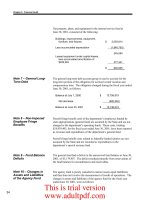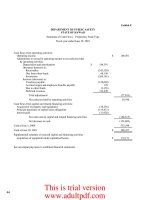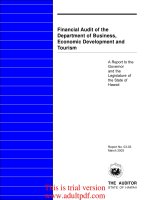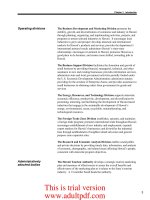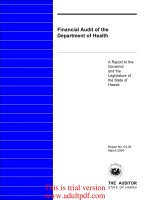Financial Audit of the Department of Hawaiian Home Lands A Report to the Governor and the Legislature of the State of Hawaii Report No. 02-13 September 2002_part2 pdf
Bạn đang xem bản rút gọn của tài liệu. Xem và tải ngay bản đầy đủ của tài liệu tại đây (208.21 KB, 10 trang )
3
Chapter 1: Introduction
Exhibit 1.1
Organization Chart of the Department of Hawaiian Home Lands
Source: Department of Hawaiian Home Lands.
Hawaiian Homes
Commission
Office of
the Chairman
Administrative
Services Office
Fiscal Office Planning Office
Information &
Community
Relations Office
Land Development
Division
Land Management
Division
Homestead
Services Division
Housing Project
Branch
Land
Management
Branch
Homestead
Applications
Branch
Master-Planned
Community
Branch
Income Property
Branch
Loan Services
Branch
Design &
Construction
Branch
Technical
Services Branch
District Operations
Branch
Clerical Services
Branch
Clerical Services
Branch
Clerical Services
Branch
This is trial version
www.adultpdf.com
4
Chapter 1: Introduction
The Housing Project Branch constructs units and awards leases for
available, existing subdivided lots. The branch also assists lessees to
arrange financing and select qualified contractors to build on their
awarded lots.
The Master-Planned Community Branch arranges the planning,
financing, design, and construction of master-planned communities. The
branch works closely with the Temporary Development Assistance
Group, which is tasked with the specific goal of expediting construction
of beneficiary housing options through private sector partnerships and
other housing opportunities.
The Design and Construction Branch plans, designs, and constructs both
off- and on-site improvements to residential, agricultural, and pastoral
subdivisions.
Land Management Division
The Land Management Division manages those Hawaiian home lands
not used for homestead purposes, including residential, agricultural, and
pastoral lands. It manages and disposes of unencumbered lands for both
long- and short-term uses in order to generate revenues and keep the
lands productive while minimizing the occurrence of vegetative
overgrowth, squatting, and illegal dumping. The division has three
branches that carry out its duties.
The Land Management Branch conducts studies on land acquisitions and
exchanges and provides for the management and disposition of non-
homestead lands and properties.
The Income Property Branch conducts feasibility studies on developing
land for commercial, industrial, business, or mixed uses, and generates
plans for developing revenue-producing sites.
The Technical Services Branch conducts and reviews appraisals,
conducts studies, and develops and maintains records for both land and
real property.
Homestead Services Division
The Homestead Services Division processes homestead lease
applications; manages programs and activities in leasing homestead lots
for residential, agricultural, and pastoral purposes; and provides
homestead lessees loans and other financial assistance. The division has
three branches that help meet its responsibilities.
The Homestead Applications Branch determines native Hawaiian
qualifications, manages programs and activities in leasing homestead
This is trial version
www.adultpdf.com
5
Chapter 1: Introduction
lots, and provides homestead lessees loans and other financial assistance.
In addition, this branch maintains applicants’ records and certifies their
eligibility for residential, agricultural, and pastoral awards.
The Loan Services Branch administers the department’s loan origination,
servicing, and collection programs.
The District Operations Branch includes district offices on Kauai, Oahu,
Molokai, Maui, and in West and East Hawaii. This branch facilitates
and processes subdivision of homestead lots, home improvement
permits, and lessee requests for lease conveyances through
successorships or transfers. The branch also updates lessee files and
successorship designations, the voluntary surrender of leases, and
enforces compliance with lease terms.
1. To assess the adequacy, effectiveness, and efficiency of the systems
and procedures for the financial accounting, internal control, and
financial reporting of the Department of Hawaiian Home Lands; to
recommend improvements to such systems, procedures, and reports;
and to report on the financial statements of the department.
2. To ascertain whether expenses or deductions and other
disbursements have been made and all revenues or additions and
other receipts have been collected and accounted for in accordance
with federal and state laws, rules and regulations, and policies and
procedures.
3. To make recommendations as appropriate.
We audited the department’s financial records and transactions and
reviewed its related systems of accounting and internal controls for the
fiscal year July 1, 2000 to June 30, 2001. We tested financial data to
provide a basis from which to report on the fairness of the presentation
of the financial statements. We also reviewed the department’s
transactions, systems, and procedures for compliance with applicable
laws, regulations, and contracts.
We examined existing accounting, reporting, and internal control
structures and identified deficiencies and weaknesses therein. We made
recommendations for appropriate improvements including, but not
limited to, the department’s forms and records, management information
system, and accounting and operating procedures.
Objectives of the
Audit
Scope and
Methodology
This is trial version
www.adultpdf.com
6
Chapter 1: Introduction
In addition, we reviewed the extent to which recommendations made in
the department’s prior external financial audit and in Chapter 2 of the
State Auditor’s Report No. 93-22, Management and Financial Audit of
the Department of Hawaiian Home Lands, have been implemented.
The independent auditors’ opinion as to the fairness of the department’s
financial statements presented in Chapter 3 is that of Grant Thornton
LLP. This audit was conducted from July 2001 through December 2001
in accordance with generally accepted government auditing standards.
This is trial version
www.adultpdf.com
7
Chapter 2: Internal Control Deficiencies
Chapter 2
Internal Control Deficiencies
Internal controls are steps instituted by management to ensure that
objectives are met and resources safeguarded. This chapter presents our
findings and recommendations regarding the financial accounting and
internal control practices and procedures of the Department of Hawaiian
Home Lands.
Our findings are summarized as both reportable conditions as well as
other significant areas of concern not considered reportable conditions.
Reportable conditions are significant deficiencies in the design or
operation of the internal control over financial reporting which, in our
judgment, could adversely affect the department’s ability to record,
process, summarize, and report financial data consistent with the
assertions of management in its financial statements.
A material weakness is the worst possible type of reportable condition.
A material weakness is a condition in which the design or operations of
one or more of the internal control components does not reduce to a
relatively low level the risk that misstatements in amounts that would be
material to the financial statements being audited may occur and not be
detected within a timely period by the employees in the normal course of
performing their assigned functions.
We found several reportable conditions and other significant areas of
concern involving the department’s internal control over financial
reporting and operations. Similar deficiencies were communicated to the
department in our Report No. 93-22, Management and Financial Audit
of the Department of Hawaiian Home Lands, and by external auditors in
prior financial audits concerning the department’s management of loans,
leases, and Hawaiian home lands.
The following matters are severe and considered material weaknesses:
1. The department does not have sufficient documentation to support its
methodology for determining the allowance for doubtful accounts for
loans receivable.
2. The department did not record expenditures for infrastructure
improvements within the proper period.
Summary of
Findings
This is trial version
www.adultpdf.com
8
Chapter 2: Internal Control Deficiencies
Other reportable conditions are summarized as follows:
3. Management is ineffective. The department’s policies and
procedures are either not enforced or are non-existent. In addition,
the department does not manage outstanding loans adequately, nor
maintain current information on the status of loans originated by
financial institutions or other lenders for which the department
guarantees repayment. Futhermore, the department does not perform
financial reporting accurately and timely.
4. Fixed assets are not properly recorded.
5. Construction costs are not properly capitalized as inventory of homes
for sale.
We also identified other significant areas of concern not considered
reportable conditions. Although these matters may not directly impact
the financial statements, they are significant to the department’s
operations. We found that the department does not have written policies
or procedures for the collection of lease and license receivables. We also
found that the department does not have a current strategic plan to guide
its programs in meeting its goals and objectives under the Hawaiian
Homes Commission Act of 1920. In addition, the list of applicants for
homestead awards has remained constant for the last five years, with
thousands of beneficiaries waiting for the opportunity to be provided
with land. Furthermore, information on applicants may not always be
current, thus precluding the department from contacting beneficiaries
about the availability of homestead leases.
The department’s allowance for doubtful accounts for outstanding loans
as of June 30, 2001 was $3.732 million. This amount represents
management’s best estimate of the outstanding loans that may not be
collectible. Since management determines this amount based on
subjective as well as objective factors, judgment is often required to
estimate the amount shown in the financial statements. Management’s
judgment is normally based on its knowledge and experience about past
and current events and assumptions about current conditions. The
estimated amount for doubtful accounts must be reasonable and
supported by relevant information and adequate documentation.
In determining the allowance for doubtful accounts, the department’s
methodology is faulty. The department assumes that upon cancelling a
loan it will repossess the real property, which serves as collateral for the
loan, and sell it to another party. Under this methodology, the
department’s loss would be the difference between the outstanding loan
The Methodology
for Determining
the Allowance for
Doubtful Accounts
for Loans
Receivable Is Not
Supported by
Sufficient
Documentation
Support for the
calculation of the
doubtful accounts
allowance is
insufficient
This is trial version
www.adultpdf.com
9
Chapter 2: Internal Control Deficiencies
plus interest balance and the sales price to the new buyer. The
department’s methodology for determining the allowance utilizes real
property tax assessed values as the basis for determining the new buyer’s
sales price. The department could not provide us with sufficient
documentation supporting the assumption that real property tax assessed
values reflect the proper value to use in estimating the uncollectible
receivables and that the value strongly correlates to the actual sales price
for which the property can be sold.
Furthermore, the department’s methodology includes applying certain
percentages to various aged loan receivable balances. The department
could not provide sufficient, reliable data supporting the use of these
percentages in determining its allowance for doubtful accounts. The
department’s inability to provide a reliable basis for the computation of
its allowance for doubtful accounts makes it impossible to determine
whether the amount recognized by the department is reasonable.
The department’s use of the previously described methodology to
compute the allowance for doubtful accounts for outstanding agricultural
loans is also faulty. We found that agricultural loans are not
collateralized by real property. Collateral is the property or asset
pledged to secure a loan. If a loan is deemed uncollectible, the lending
institution may seize the property or asset used as collateral. However,
the department cannot recover uncollectible amounts through real
property repossession because real property is not pledged as collateral
for its agricultural loans. Applying this faulty methodology to determine
uncollectible amounts for its agricultural loans is questionable. The
department could not provide sufficient, reliable data supporting the use
of this methodology for its agricultural loans. Outstanding agricultural
loans and related interest receivable as of June 30, 2001 amounted to
approximately $799,000. Of this balance, approximately $488,000, or
61.1 percent, of the loan payments due was outstanding for 60 days or
more.
Historically, the department has not experienced significant losses due to
uncollectible mortgage loans. This is due primarily to the resale values
on foreclosed properties actually exceeding the outstanding loan and
interest balances for the cancelled loans. The latter proves that there is
limited correlation between the actual sales price of the properties and
the methodology used to determine the department’s allowance for
doubtful loan accounts.
Without sufficient documentation, we were unable to determine the
reasonableness of the estimates for uncollectible loan receivables and the
accuracy of the financial statements. Management must base its estimate
on relevant, sufficient, and reliable data. Failure to do so may result in
improper financial reporting.
Method used to
calculate the allowance
for doubtful accounts
for agricultural loans is
questionable
This is trial version
www.adultpdf.com
10
Chapter 2: Internal Control Deficiencies
The Department of Hawaiian Home Lands should obtain sufficient
documentation for determining its allowance for doubtful accounts for
loans. The department should also reevaluate the methodology for
determining its allowance for doubtful accounts for loans and ensure the
uncollectible loans estimate is properly calculated.
The Department of Hawaiian Home Lands did not properly record its
prior year liability for infrastructure improvements, thereby misstating its
current and prior year financial statements. In the year ended June 30,
2000, the department received certain land parcels in Kealakehe, Hawaii.
As part of the transaction, the department was supposed to reimburse the
Department of Business, Economic Development and Tourism’s
Housing and Community Development Corporation of Hawaii a total of
$1,816,100 for infrastructure improvements to the land. This
reimbursement was to be made over a three-year period.
Instead, the department recorded the entire $1,816,100 as an expenditure
in the year ended June 30, 2001. In accordance with accounting
principles generally accepted in the United States of America (GAAP),
expenditures should be recorded in the accounting period in which the
fund liability is incurred. GAAP provides reporting standards by which
financial statements should be prepared. Therefore, the $1,816,100
should have been recorded as a liability as of June 30, 2000 and as an
expenditure for the year ended June 30, 2000. This error resulted in the
underreporting of liabilities and expenditures in FY1999-00. Since the
department did not correct this error in accordance with GAAP, its
FY2000-01 expenditures were overstated by $1,816,100.
Failure to report all expenditures and liabilities in the proper period
provides a misleading picture of an institution’s financial condition. In
addition, failure to properly correct the accounting error results in
inaccurate financial statements. This accounting error may also cause
the public, private businesses, and government officials to rely on
misleading and inaccurate financial statements. Such reliance could also
result in poor and misinformed decision-making.
The Department of Hawaiian Home Lands should review its internal
control policies and procedures and ensure that all expenditures and
liabilities are properly recorded.
Recommendations
Infrastructure
Improvements Are
Not Recorded in
the Proper
Accounting Period
Recommendation
This is trial version
www.adultpdf.com
11
Chapter 2: Internal Control Deficiencies
The Department of Hawaiian Home Land’s management is ineffective
and does not ensure that all necessary accounting policies and procedures
are in place and enforced. Outstanding loans and guaranteed loans with
outside lenders are improperly managed. Accurate and timely financial
reporting is not required by management. Written collection policies and
procedures for lease and license receivables are non-existent.
The department does not properly manage its outstanding loans. Its
inability to effectively maintain, monitor, and collect outstanding loans
could cost the State and Hawaii’s taxpayers millions of dollars. In
addition, qualified, eligible beneficiaries may not be able to receive
assistance because loan moneys are tied up in delinquent loans which are
unlikely to be repaid.
In FY2000-01, the department granted loans totaling $3,267,294;
however, it could not provide the number of loans granted or the average
time an applicant waited for loan approval or homestead land
availability. There are currently 19,641 applicants on the waiting list for
homestead lands.
As of June 30, 2001, the department also had about $47 million in
existing outstanding loans. Of this balance, $4.5 million, or 9.7 percent,
were outstanding for 60 days or more. The department considers a loan
to be delinquent if no payments have been made for 60 days or more. As
of June 30, 2001, the department had a total of 1,359 loans outstanding,
of which 526 were delinquent, with loan payments totaling
approximately $4.5 million. These figures equate to a delinquency rate
of about 39 percent. Historically, the department’s loan delinquency rate
has been close to 40 percent. In comparison, the average delinquency
rate for mortgage loans in Hawaii generally is 2.81 percent, according to
the Mortgage Bankers Association of America’s 2001 Second Quarter
Report. It is imperative that the department make the collection of
delinquent loans a high priority. The longer a loan remains delinquent,
the less likely it will be collected.
High delinquency rates exist for a number of reasons. In addition to
departmental inefficiencies, the loans themselves pose a high risk. Many
current lessees cannot obtain loans from commercial institutions and rely
on the department’s assistance because its credit approval policies are
much more relaxed than those of a commercial lending institution. The
department approves many more “high risk” applicants than a
Management Has
Failed to Ensure
That All
Departmental
Accounting
Policies and
Procedures Are in
Place and
Enforced
Management of
outstanding loans is
deficient
This is trial version
www.adultpdf.com
12
Chapter 2: Internal Control Deficiencies
commercial lender would. Therefore, the department runs a high risk of
incurring a large number of delinquencies at the outset. As a
consequence, the department needs to actively monitor loans and enforce
collection policies to control the level of delinquent loans.
Furthermore, the department’s loan system does not benefit from
existing technology used by commercial institutions which could
automate many of the tasks now performed manually. Currently, the
department’s system generates loan reports that must be manually sorted
for distribution to the proper loan officers. Delinquency notification
letters are also generated by hand. Loan officers physically review
payment reports to determine which lessees should receive notices.
Automating these tasks would free loan officers to spend more time
performing their other duties.
Overall, we found that the department has numerous problems. It does
not enforce written collection policies relating to outstanding loans, does
not consistently maintain documentation on delinquent loans, does not
ensure loan records contain valid addresses, is increasing financial
assistance to lessees, and continues to accrue interest on loans related to
cancelled leases.
Written collection policies are not enforced
The department does not follow its written delinquent loan policies,
which prescribe the following actions to take when loan payments
become outstanding for over 30 days:
• Over 30 days outstanding – Reminder notices are sent to lessees
along with monthly statements.
• Over 60 days outstanding – A departmental representative
contacts lessees by phone, personal visit, or a letter.
• Over 90 days outstanding – A departmental representative visits
lessees to arrange payment plans or solicit promises to pay. If
payments are not received by the agreed-upon date, a
departmental representative and the lessee meet to rectify the
delinquency.
• Over 120 days outstanding – After all collection efforts have
failed, the delinquent borrower is referred to the Hawaiian
Homes Commission for a citation hearing. Upon approval by the
commission, a citation hearing is conducted, wherein the
collection officer presents the account history and recommends
action in the borrower’s presence. The commission then renders
its decision. If the commission cancels the lease, eviction
proceedings commence.
This is trial version
www.adultpdf.com
